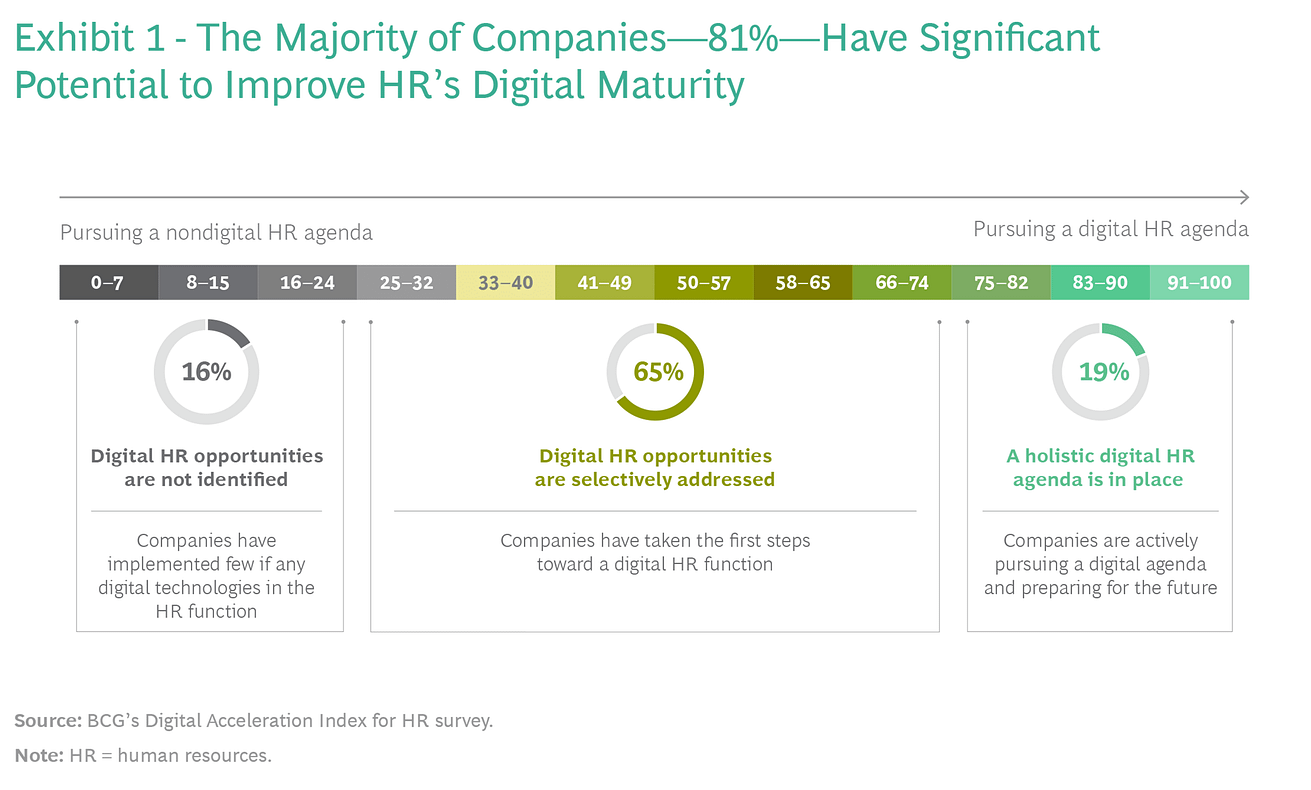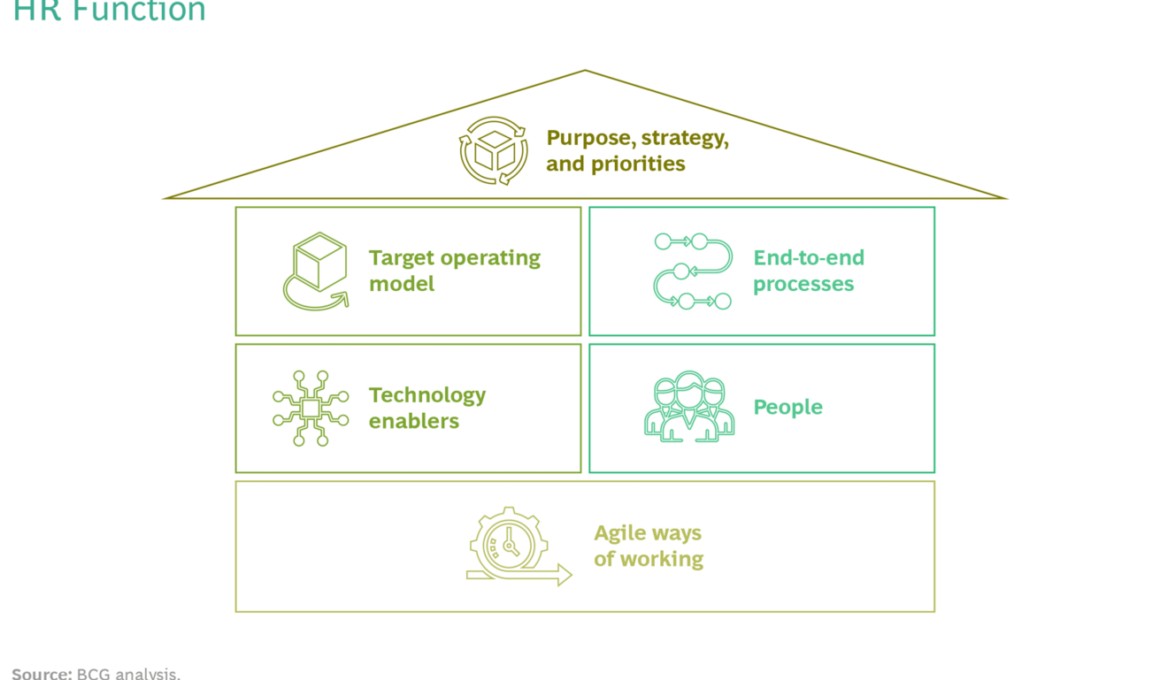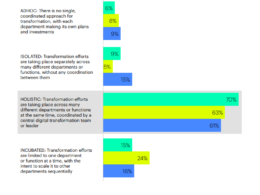MAY 10, 2022
By Jens Baier, Martin Twesten, and Pragya Maini
Improving the digital maturity of the human resources function is increasingly critical to conducting business efficiently and competing for talent.
Digital HR capabilities are enabling companies to redefine the onboarding experience, personalize learning and development offerings, and better manage engagement and performance to attract, connect with, and retain talent.
Digital interactions not only meet employees’ and prospects’ expectations but also significantly reduce costs.
To better understand how companies are charting a path to digital maturity for their HR function, we conducted a Digital Acceleration Index (DAI) survey for HR to gain insight into the challenges facing the HR function.
We found that the companies implementing digital technologies in the HR function are far outpacing their peers and competitors in performance measures such as efficiency, productivity, and retention.
And we identified six building blocks that all companies can use to close HR’s digital maturity gap-the difference between HR’s current digital capabilities and the capabilities it needs to achieve its digital ambition.
Over the past two years, digital leaders have been augmenting human capabilities in HR with technology to create a robust, fit-for-future, bionic HR function that enables end-to-end digital HR journeys.
Typically, each of these companies set up a command center to drive its digital transformation in HR.
Each then tasked its center with developing digital capabilities that would enable HR to use algorithms to recruit and assess talent, for example, and to personalize employee development programs.
To accelerate the transformation, the command center introduced agile ways of working.
As a result, digital leaders’ HR functions are aggressively and proactively rolling out highly personalized services and experiences throughout employees’ HR journeys to deliver what individuals need.
The best-in-class companies have made big gains in three key areas:
1.Efficiency.
Digital leaders have become more efficient and, thus, reduced HR costs by more than 30%.
They are using technologies to automate low-value activities and repetitive tasks.
And they are reviewing process efficiency metrics and service levels regularly to maintain highly efficient operations.
Digital leaders are also continuously looking for ways to lower costs further.
2.Productivity.
Best-in-class companies have boosted productivity in the HR value chain by more than 20%.
They are using data to understand key pain points, which helps them make better decisions and provide better business services, and they are deploying targeted HR tools to run core businesses more efficiently.
By taking these steps, HR’s leadership has more time to focus on the top people priorities, business investments, and other critical issues.
3.Employee Experience.
Digital leaders have increased employees’ satisfaction and raised retention rates by 30% to 40%.
Internal and external talent expect automated, digitized, user-centric experiences, and these companies understand that.
They are prioritizing moments that matter to strengthen their relationships with employees and retain talent.
And they are using data and analytics to personalize employees’ HR journeys to increase engagement.

Most Companies Struggle to Achieve Digital Maturity
On a scale of 1 to 100, the most digitally mature companies scored 75 or higher on DAI for HR and accounted for about 20% of all participants.
The top performers are actively pursuing a holistic digital HR agenda and preparing for the future.
But the vast majority of organizations in the survey-81%-have significant potential to improve HR’s digital maturity and performance.
Nearly two-thirds have taken just the first steps toward a digital HR function, while another 16% scored below 25 on DAI for HR and have implemented few if any digital technologies in the HR function. (See Exhibit 1.)
In many cases, companies are held back because they haven’t defined their digital ambition for HR, or they don’t have the talent to make the transition happen.
Another problem is that their decision-making process often lacks agility and can’t keep up with digital developments.

It’s worth noting that these are aggregate numbers. Digging deeper into the results shows that digital maturity varies greatly by industry, influenced by specific cost pressures, market and customer expectations, and an openness to change. While a company’s industry is an important factor in its digital maturity, it’s certainly not the sole determinant. Each company is unique and needs to determine its current and target digital maturity and to identify opportunities to deliver exceptional HR services. (See “About BCG’s Digital Acceleration Index for HR.”)
For example, a leading pharmaceutical company used DAI for HR to formulate its digital HR transformation strategy and identify opportunities to upgrade its technology system, upskill employees, and optimize processes end to end. The company reduced the time each employee spent on onboarding by 20 hours, and it cut the time spent by HR employees on answering onboarding- and off-boarding-related queries by 50%. These successes improved satisfaction among HR employees, who could devote more time to value-adding tasks and working on the organization’s people strategy for the digital transformation.
Six Building Blocks to Deliver Better HR Services
The good news for companies that aspire to improve the digital maturity of their HR function is that there is a clear pathway for doing so. BCG’s DAI for HR survey revealed that best-in-class companies use six key building blocks to construct their digital HR efforts. (See Exhibit 2.)

Purpose, Strategy, and Priorities. A company’sleaders must define the digital ambition for HR and ensure that this ambition serves the company’s overall business purpose. Leaders also must create a strategy for identifying gaps in their digital HR capabilities (a strategy that uses internal and external benchmarking) and for closing those gaps. And it’s critical that leaders carefully prioritize HR use cases that will generate value for the company, assign clear milestones and deliverables, and integrate these use cases into the organization’s broader digitization roadmap.
Target Operating Model. A cross-functional team should define a new HR operating model that includes agile ways of working. Strong central governance-perhaps through a center of excellence for digital projects-is important in order for the cross-functional team to systematically assign roles and responsibilities and, ultimately, implement the target operating model.
End-to-End Processes. A company needs to design key processes that enable HR to perform six responsibilities:
- Analyzing, Planning, and Reporting. Using data and analytics to improve skills-based workforce planning and reporting and to better link those efforts to the business strategy.
- Attracting and Recruiting Talent. Finding candidates for jobs and educating them on their roles and ways of working.
- Assessing and Developing Employees. Helping staff members improve their performance and grow in their roles, and providing clarity on the next career steps and required skills.
- Engaging and Supporting Team Members. Motivating and rewarding employees, connecting them with others in the organization, and resolving disputes.
- Developing Career Action Plans. Helping employees plan their career paths and ensuring that they get the appropriate experience and develop the right expertise.
- Managing Employee Data and Pay. Providing a unified view of employee data with real-time HR reporting, and supporting the management-employee relationship.
To facilitate HR’s success, a company should ensure that HR’s processes interface smoothly with those of adjacent functions and systems. Moreover, to engage employees, a company should make ease of use a top priority when digitizing HR’s processes.
Technology Enablers. Critical to constructing a digital HR function isimplementing a scalable and modular technology architecture that includes the existing core HR information system and other data platforms (for example, platforms for performance management, learning and development, and benefits). A company should also build an integration layer so that all HR applications can work together seamlessly.
To ensure that the HR function maintains its digital edge, a company should monitor new and evolving technologies-again, perhaps through a center of excellence for digital projects-and help HR implement them. These technologies may include artificial intelligence (AI) for recruiting, analytics to monitor employee engagement, and gamification for training and development. Moreover, company leaders must maintain a robust vendor review and selection process to ensure quality. As it stands, most chief human resources officers are overwhelmed by the ever-widening array of new technologies to consider.
In 2021, more than $12 billion in venture capital poured into the HR technology market, with the rate of investment more than tripling from 2020 to 2021.
People. A company shouldrecruit employees who have digital skills (including expertise in user experience design, AI, and robotic process automation) and the ability to work in multidisciplinary, collaborative teams. It’s also important to upskill the current workforce through ongoing training and development-and offer them clear digital career paths.
Agile Ways of Working. A company should introduce agile ways of working within HR and across functions to speed up the digital transformation of HR (through more frequent and faster iterations of new digital processes). To ensure that employees embrace the new ways of working, a company should invest in training and the appropriate technical platforms that facilitate collaboration.

How to Begin the Digital Transformation Journey
While the six building blocks are all vital to constructing a digital HR function and delivering exceptional HR services, many companies still struggle with how to get the process underway. We recommend three steps.
Define the digital ambition for HR. Using a holistic digital HR maturity assessment, evaluate HR’s current maturity and pain points, as well as industry trends. With this assessment in hand, company leaders can define the digital ambition and target state for digital maturity.
Identify the starting point. Getting the starting point right is critical to ensure that the company begins with use cases or digital initiatives that are most likely to deliver quick wins (which will provide momentum for the digitization journey) and a strong return on investment. (See Exhibit 3.) For example, HR functions with a low level of digital maturity can start with use cases to prove the value of digitization, while those with greater maturity can begin by reimagining end-to-end journeys. No matter the starting point, the ultimate ambition of all companies should be a full HR transformation to deliver exceptional HR services.
Build critical capabilities. The company must define and build the new HR skills and roles that are needed to support the starting point and the prioritized use cases and digital initiatives. When building these critical capabilities, it’s important to incorporate the ability to learn and course correct.

To attract and retain talent, to keep HR professionals engaged, and to improve HR’s efficiency, companies need to advance the digital maturity of their HR function. For most companies, the journey has only begun, and it presents numerous challenges, not the least of which is adapting to new, more agile ways of working. But the outstanding HR performance of best-in-class companies shows the benefits of pursuing this transformation. By assessing HR’s digital maturity and using the six building blocks to construct a digital HR function, every company can pursue its own HR transformation journey.
Originally published at https://www.bcg.com on May 5, 2022.













